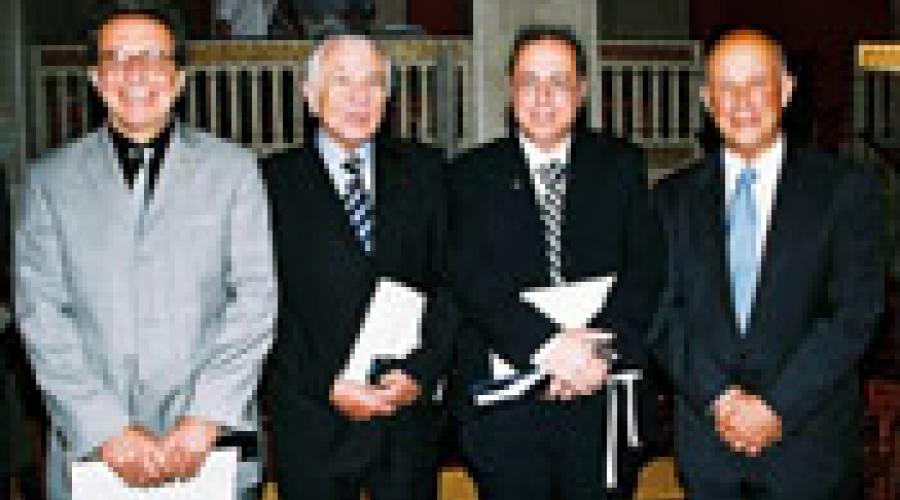
The Aristeio Bodossaki award for excellence was presented to two internationally renowned Greek scientists in Mathematics. The presentation of the award was held on 14 June 2006 at the University of Athens in the presence of the President of the Republic, Mr Karolos Papoulias. The award was presented to Mr Athanasios Fokas, Professor at the University of Cambridge and full member of the Academy of Athens, for his contribution to solving problems in non-linear differential equations with partial derivatives, as well as the application of these methods in many different areas of science; and Mr Dimitrios Christodoulou, Professor at the Swiss Federal Institute of Technology in Zurich (ΕΤΗ Zurich), for his important contribution to the general theory of relativity and gravity.
A major criterion for the selection of the winner of the 150,000 euro prize, was the extent to which candidates contributed to the advancement of their scientific field via an innovative and integral work, which received international recognition. The Aristeio Bodossaki prize was established in 2002 and is awarded every two years by the Bodossaki Foundation to internationally renowned Greek scientists in Positive and Technological Sciences as well as Medicine.
Athanasios Fokas: Mathematics Applied to the Study of Medical Images
Professor A. Fokas was born in Kefalonia in 1952. He studied Aeronautics at London's Imperial College and obtained a doctoral degree in Applied Mathematics from the California Institute of Technology as well as a Medical Degree from the University of Miami. He was a Professor at Clarkson University and London's Imperial College. Since 2002 he has chaired in Non-Linear Mathematics Science at the University of Cambridge. He is a member of many international committees, a full member of the Academy of Athens and President of the Governing Body of the National Library of Greece.
He has published more than 220 scientific articles in a variety of scientific fields such as mathematical models for leukaemia, magnetoencephalography, variable equations, fluid mechanics, prediction of the quaternary structure of proteins, and mathematic techniques with medical images. The international organisation ISI-Web of Science includes A. Fokas in the list of most frequently cited scientific researchers in Mathematics.
A. Fokas has made crucial contributions to the precise analysis of a large class of differential equations. In particular, he developed a 'unifying method of integral transforms', which is considered amongst the most important discoveries in the field of analytic solutions of differential equations since the classic period of mathematical discoveries in the 18th century. Notably, the Journal of Mathematical Physics presented this method in its anniversary edition published for the 2nd millennium, which summarised the most important discoveries of the 20th century in the field of mathematical physics':
Professor A. Fokas contributed significantly to the resolution of two problems, which remained unsolved in the field of medical imaging. More specifically, he contributed to the solution of the basic mathematical problems involved in photon-emission tomography and magnetoencephalography.
Prof. Fokas' team, in cooperation with London's Institute of Nuclear Medicine has made decisive contributions to the discovery an analytical formula that resolves the basic problem in photon-emission tomography (SPECT). The arithmetic application of this new formula is expected to lead to drastic improvements of spatial resolution potential of SPECT, in order for it to become as precise as positron-emission tomography (PET). This advance is particularly important as SPECT, unlike PET, does not require cyclotrons, which means it could potentially be available in all hospitals.
As for magnetoencephalography (MEG) -a technique that takes images of the functioning brain- the main mathematics problem lies in calculating the electric field in the brain from the measures of the respective magnetic field outside the brain. Prof. Fokas and his research team, in cooperation with the mathematician I.M. Gelfand, devised an analytical formula for determining the current created by neurons based on measures of the magnetic field outside the brain. Early tests show that this new algorithm gives more precise results than the models used up to now. The expansion and verification of these results will make magnetoencephalography an important clinical method for studying the dynamics of the brain and obtaining crucial information for the diagnosis of neurological disorders.
Dimitrios Christodoulou: Studying the Theory of Relativity
Dimitrios Christodoulou was born in Athens in 1951. He completed his graduate and post-graduate studies in Physics at the University of Princeton. He had just turned 20 when he received his doctoral diploma from Princeton, in 1971. He has been teaching at the Universities of Athens, Cyracuse and Princeton. Since 2001 he teaches Mathematics and Physics at ETH Zurich (Swiss Federal Institute of Technology).
Prof. Christodoulou has received many awards including the Bocher prize -the most significant award from the American Mathematical Society- and the Order of the Phoenix from the President of the Hellenic Republic. He has been awarded Honorary Doctorates from 4 Universities, he is a member of the American Academy of Arts and Science and the European Academy of Science.
His scientific work is in the field of partial differential equations, differential geometry, general relativity and hydrodynamics. Many of Prof. Christodoulou's works are of fundamental significance for the development of certain areas of mathematics.
His monograph 'The Global Nonlinear Stability of the Minkowski Space' regarding Einstein's theory of relativity, written in cooperation with Sergiu Klainermann, is considered particularly significant as it proves the stability of the space-time level of the special theory of relativity in the context of the general theory.
Also significant is his monograph 'The Formation of Shocks in 3-Dimensional Fluids', dealing with Euler equations on the flow of compressed fluids. This monograph consists of a detailed analysis of what occurs, after a significant length of time to an initial disruption of a confined space inside any compressed fluid. It also shows that, after an adequate length of time has elapsed (depending on the size of the initial disruption), the wave fronts become unlimitedly condensed based on the length of certain surfaces in the time-space field, from which discontinuations called shock-waves are developed. This problem was examined for the first time by the German mathematician B. Riemann, in 1858, but only for the much simpler circumstance of one spatial dimension. D. Christodoulou's work is the first to deal with the real physical problem in three-dimensional space and provides a complete and detailed picture of the formation of shock-waves.







